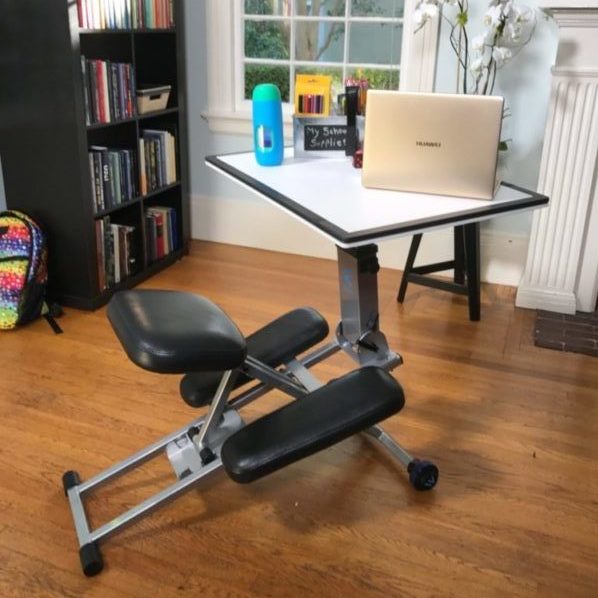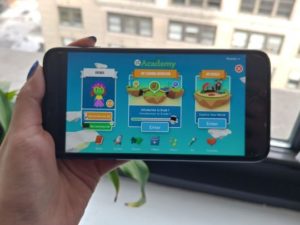
The old parental cry, “Is your homework done?” is like Kryptonite to kids. And claims of, “I’m doing it all right now!” shouted from behind the bedroom door are like nails on a chalkboard to parents, too.
So how can you cut down on the homework drama? Let a few smart tech tools come to the rescue.
Set up a dedicated space

Edge Desk, the Kickstarter hit that comes fully assembled, flat in the box, then folds up like a stroller into several different positions for an instant workspace anytime, anywhere. (Photo: Edge Desk/Handout)
First, you need to decide where your kid should tackle his or her school assignments. In my family, clutter equals chaos, but sometimes space can be hard to come by. The Macgyver-style Edge Desk hit a homerun on Kickstarter and after using it for a few months now, it’s easy to see why. It’s one compact piece of furniture that transforms into whatever you need — a sit-down desk, chair, standing desk, or even an art-friendly easel. It’s like a Murphy bed made for productivity, and it tucks away in an instant.
Before we bought the Edge Desk, my daughter used a sideboard/buffet type table next to our dining room table. It’s the perfect height for her to use as a standing desk (which she loves after sitting all day), and we cleared out old cloth napkins and knick-knacks from the top drawer and put her pens, pencils and other school supplies in there. When we wanted to do homework together, we just migrate to the dining room table. The whole point is, have a cleared-out space that’s designated for homework — not in their bedrooms.
Stock it up
Now that you have an actual space set up, you need the right tools for the job. There’s nothing worse than having a motivated kid ready to master some math problems and then realize your last pencil just went through the washing machine. Stock up on pencils, pens, a proper sharpener, glue, and a stapler, and you’ll never have to delay a homework session for a run to the office supply store.
Limit distraction
The hardest part of all will probably be getting your child to focus. That smartphone glued to their forehead isn’t doing them any favors when it comes to scoring good grades, so make a rule to keep their app-packed phone out of sight when it’s time for school work. But what about when they need to confer with classmates on projects via text or video chat? Try an app like unGlue to make sure they have access to what they need, without the distraction of all those Snapchat streaks and YouTube videos.
Some routers also let you block certain sites, like Netflix, while keeping streams open for learning portals like Khan Academy.
Invest in the right tools

Huawei Matebook X, one of the “new kids on the block” when it comes to laptops. Whatever laptop you have as a family, be sure your security settings are updated, passwords set and safe, and that you’re backing up to the cloud or a hard drive, or both. (Photo: Huawei/Handout)
Of course, gadgets aren’t all bad when it comes to education, and sooner, rather than later, they’ll need a solid laptop, with no bugs, glitches, or distractions. Since so much studying, writing, practice, and reading happens on the same screen these days — it pays to invest wisely in one that you can all depend on — whether a laptop, Chromebook, or tablet.
I’ve just finished reviewing several, including the newest kids on the block, the Huawei (that’s “wah-way” in case you were wondering) Matebook X. It does all the work of a tablet and a notebook in one solid laptop that’s incredibly slim and light. It doesn’t take up much room on the study desk, and its 7th-generation Intel processor has the power to handle any school-related task you can throw at it.
Whatever you’re using, make sure your security software is up to date — protecting against viruses, online threats, risky websites and dangerous downloads. Double check passwords, too. Yes — you will always need to be privy to theirs, for their own safety. And, make sure you’ll all backing-up data, whether to the cloud or to a secure external drive — or both.
Turn down the noise
Throw in a pair of decent earplugs if your child is easily distracted. I swear by the DUBS Noise-Cancelling reuseable earplugs. My daughter also swears by listening to music to help her concentrate and keep her energy up, so a good pair of noise cancelling headphones or earbuds can help here, too.
If you really want to be the “cool” parents, pick up an Amazon Echo or Google Home so they can ask basic questions and get answers in an instant without searching. Add a great note-taking app that syncs across all of their devices — Microsoft’s OneNote and the incredibly popular Evernote are both great for this — and you have homework tech conquered.
Set time limits
As tempting as it can be to just tell your hard-working student to hammer through their work and have fun later, overwhelming them is a recipe for disaster. I often help my daughter create a schedule, and we use a simple timer to break up study time. A half hour of hard-nosed English, then a ten minute break, or maybe an hour of science reading followed by a ten-minute breather.
This is incredibly important, and since the National Education Association and even the National PTA endorse the “10 minute rule” — 10 minutes of homework per student, per grade level, so a fifth grader might have 50 minutes, while a high schooler can have as much as two hours — this gets even more important as your child gets older. (Quick reality check here though, my 11th grader has four to six hour of homework at least five nights a week, so helping them with time management is crucial!)
Create good habits early

LeapFrog Academy, built for 3-6 year olds, can help get younger kids started on healthy homework habits from the start. (Photo: Leapfrog Academy/Handout)
Feed body and mind

Graze, healthy snacks are often just a subscription box away. This is a great idea for college students. (Photo: Graze/Handout)
We can’t forget about the creature comforts, right? Make sure your studying student isn’t trying to slog through math problems with a grumbling stomach. If you’re already a master at healthy snacking then you know what I’m talking about, but if you need a little help on that front I recommend Graze. It’s a subscription service that delivers healthy, interesting snacks right to your door, all perfectly portioned and ready to eat, and saves you a trip to the store. That’s a win-win if I’ve ever seen one.
